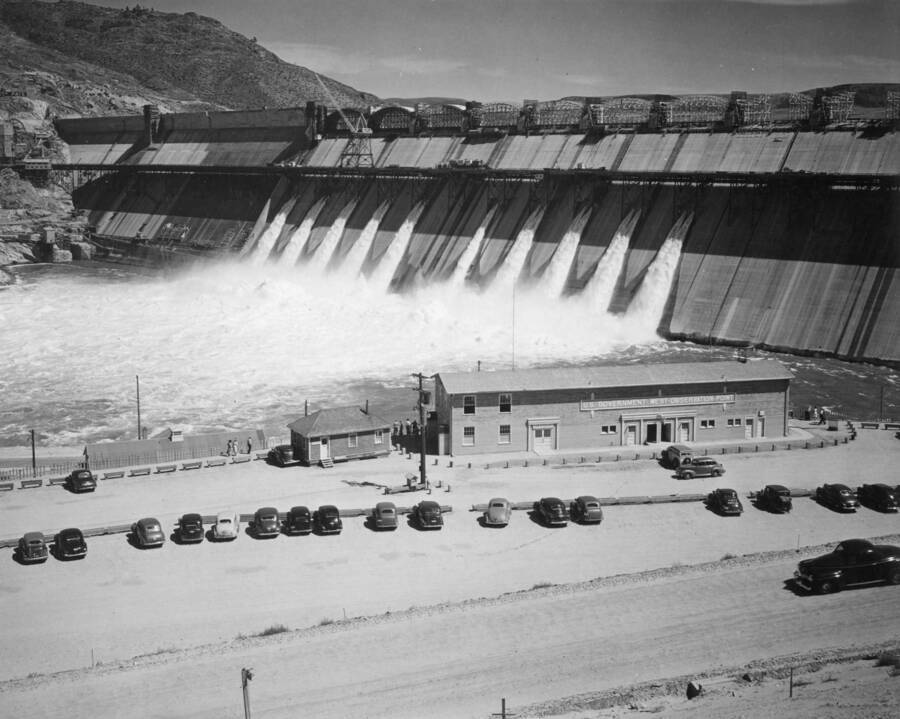Columbia River Basin Project: Dam Construction in the Pacific Northwest
Historical photographs of Columbia Basin Project and other dams constructed in the Pacific Northwest, 1933-1965
Contents: About the Collection | Dams Depicted in the Collection | The Columbia Basin Project | Research Value | Tech
About the Collection
For a detailed description and inventory of the contents of the collection, please see our finding aid. The collection is physically held in Special Collections & Archives at University of Idaho Library.
This collection contains around 500 historical photographs collected and/or taken by the Army Corps of Engineers during the construction of various hydroelectric dams in Washington, Oregon, and Idaho between 1933-1965. The bulk of this collection documents the Columbia Basin Project, which resulted in the construction of the Grand Coulee Dam in central Washington state and the largest water reclamation project in the United States, supplying irrigation water to over 670,000 acres.
The first 14 folders of the archival collection contain black and white photographs (8x10 inches) of various dam construction scenes in Washington and Idaho. The majority of photographs document the construction of the Grand Coulee Dam in Washington. Other dams include:
Dams Depicted in the Collection
- Long Lake Dam, two miles northeast of Stratford, Washington and later renamed Pinto Dam
- McNary Lock and Dam
- Dworshak Dam , two miles upstream on the North Fork of the Clearwater River from the town of Ahsahka, Idaho
- John Day Lock and Dam , on the Columbia River
- Lucky Peak Dam , a flood control project on the Boise River 9 miles upstream from Boise, Idaho
- Ice Harbor Lock and Dam , on the Snake River
- Little Goose Lock and Dam , on the Snake River
- Lower Granite Lock and Dam, at Snake River mile 107.5
- Asotin Dam , on the Snake River
- Grand Coulee Dam
The Columbia Basin Project
The bulk of this collection documents the history of the Columbia Basin Project, a large irrigation project in the Columbia basin of central Washington state. As of April 2020, the Bureau of Reclamation website indicates that the “Columbia Basin Project serves about 671,000 acres in east central Washington….There are over 300 miles of main canals, about 2,000 miles of laterals, and 3,500 miles of drains and wasteways on the project.”1 The irrigation system provides irrigated water to farms but also electricity and water for much of Washington state.
The project began with the construction of the Grand Coulee Dam which took place between 1933-1942. In 1943, “Congress authorized the Columbia Basin Project” but “construction of the irrigation system did not start until after World War II.”1 During WWII, the dam provided massive amounts of energy to the burgeoning aluminum and aircraft industries of the Pacific Northwest, contributing to one of the primary factors of the ultimate Allies victory in WWII. A significant percentage of that power, it was later revealed, was also diverted to the Hanford Nuclear Site, a crucial component of the Manhattan Project.
The Columbia Basin Project irrigation system began pumping water “from the Columbia River near Pasco in 1948 and was delivered to about 5,400 acres. The irrigation system carried its first water from Grand Coulee Dam to about 66,000 acres in spring of 1952.”1 Since then, the system has irrigated about 2.5 million acre-feet of water from the Columbia River annually, much of that water being reused as “Potholes Reservoir collects runoff from the north for farms in the south.”1
While the Grand Coulee Dam has played a crucial role in United States and world history, it has also had a profoundly negative impact on species and communities native to the region. The dam permanently blocks important fish species, such as salmon and steelhead, from over 1000 miles of spawning ground in the Upper-Columbia River. As a result, Native American populations that depend on the fish for their way of life have lost traditional fishing grounds. The creation of Lake Roosevelt also eliminated habitats for numerous species, including mule deer.
Research Value
Donated to the library by the University of Idaho College of Engineering, the Columbia River Basin Project: Dam Construction in the Pacific Northwest collection is important for several reasons. First, each image has detailed descriptive metadata and captions, giving researchers a special insight into the construction methods, equipment, locations, and photographers associated with the Columbia Basin Project and the construction of other dams in the Pacific Northwest. Even the contracting companies responsible for carrying out particular projects are listed in the metadata.
Second, the artistic quality of photography during these projects provides viewers with an understanding of the human element, and superhuman scale, involved in the construction of these dams. The photographers responsible for the collection perform a superb journalistic balancing act by documenting the technical aspects of the construction while capturing the grand ambitions and accomplishments of the people behind it.
-
Brougher, Lynne. “Columbia Basin Project,” Government. Bureau of Reclamation, January 23, 2019, https://www.usbr.gov/pn/grandcoulee/cbp/index.html. (Archived: https://perma.cc/8RG4-N5TL) ↩ ↩2 ↩3 ↩4
Technical Credits - CollectionBuilder
This digital collection is built with CollectionBuilder, an open source framework for creating digital collection and exhibit websites that is developed by faculty librarians at the University of Idaho Library following the Lib-Static methodology.
Using the CollectionBuilder-CSV template and the static website generator Jekyll, this project creates an engaging interface to explore driven by metadata.




